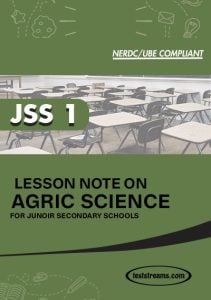This Free Agricultural Science Lesson Note JSS 1 was pulled from our book (Lesson Note on AGRICULTURE for JSS1 MS-WORD); Compiled to serve as a reference material to help teachers draw out their lesson plan easier, saving you valuable time to focus on the core job of teaching.
The Free Agricultural Science Lesson Note JSS 1 are based on the current NERDC curriculum (UBE compliant)
This Agricultural Science Lesson Notes Covers The Following Topics
1. MEANING AND IMPORTANCE OF AGRICULTURE
2. FORMS OF AGRICULTURE
3. TYPES OF AGRICULTURE
4. BRANCHES OF AGRICULTURE
5. CROP PLANT FORM
6. CROP PLANT FORM II
7. CROP PLANT FORM (MONOCOTYLEDON AND DICOTYLEDON)
8. CONSTRUCTION OF VEGETABLE BEDS
9. AGRICULTURAL IMPORTANCE OF FARM ANIMALS
10. CLASSIFICATION OF CROPS BASED ON LIFE CYCLE
11. CLASSIFICATION OF FARM ANIMALS
12. CHARACTERISTICS OF SELECTED FARM ANIMALS
13. METHOD OF WEEDS AND PEST CONTROL
14. WEEDS (II)
15. PESTS OF CROP PLANTS AND CONTROL
16. FACTORS OF PRODUCTION
17. FACTORS OF PRODUCTION – LABOUR
18. FACTORS OF PRODUCTION – CAPITAL
19. FACTORS OF PRODUCTION – ENTREPRENEUR (FARM MANAGER)
20. EXCURSION TO A WELL-ESTABLISHED FARM.
21. FUNCTIONS AND PROBLEMS OF A FARM MANAGER
Week 1
Topic: MEANING AND IMPORTANCE OF AGRICULTURE
Contents:
What is Agriculture?
Branches of Agriculture
Importance of Agriculture to man and natural economy
A. What is Agriculture?
Agriculture means all the activities involved in rearing of animals and cultivation of crops for man’s and the nation’s benefits. The word agriculture was derived from two Latin words which are ‘agar’ and ‘culture’ meaning ‘land’ and ‘cultivation’. Agriculture is often defined by many people as the cultivation of land. As a science, it deals with the systematic study of plants and animal lives in their environment and seeks to provide natural conditions for them so as to produce the best quality which are used directly or indirectly by man.
B. Branches of Agriculture
There are seven different branches of agriculture by industry, these include
• Aqua farming
• Farming
• Apiculture (Beekeeping)
• Forestry
• Fishing
• Ranching
• Whaling
Aquaculture:
Aquaculture, also known as aqua farming, is the farming of aquatic organisms such as fish, crustaceans, molluscs and aquatic plants. Aquaculture involves cultivating freshwater and saltwater populations under controlled conditions, and can be contrasted with commercial fishing, which is the harvesting of wild fish. Broadly speaking, finfish and shellfish fisheries can be conceptualized as akin to hunting and gathering while aquaculture is akin to agriculture. Mariculture refers to aquaculture practiced in marine environments and in underwater habitats.
Farming:
Farming is the growing crops or keeping of animals by people for food and raw materials. Farming is a part of agriculture.
Apiculture:
Beekeeping (or apiculture, from Latin: apis “bee”) is the maintenance of honey bee colonies, commonly in hives, by humans. A beekeeper (or apiarist) keeps bees in order to collect their honey and other products that the hive produces (including beeswax, propolis, pollen, and royal jelly), to pollinate crops, or to produce bees for sale to other beekeepers. A location where bees are kept is called an apiary or “bee yard”
Forestry:
Forestry is the science, art, and craft of creating, managing, using, conserving, and repairing forests and associated resources, in a sustainable manner, to meet desired goals, needs, and values for human benefit. Forestry is practiced in plantations and natural stands. The challenge of forestry is to create systems that are socially accepted while sustaining the resource and any other resources that might be affected. The forest science has elements that belong to the biological, physical, social, political and managerial sciences
Fishery:
Generally, a fishery is an entity engaged in raising or harvesting fish which is determined by some authority to be a fishery. A fishery is typically defined in terms of the “people involved, species or types of fish, area of water or seabed, method of fishing, class of boats, purpose of the activities or a combination of the foregoing features”. The definition often includes a combination of fish and fishers in a region, the latter fishing for similar species with similar gear types. A fishery may involve the capture of wild fish or raising fish through fish farming or aquaculture.
Ranching:
Ranching is the practice of raising herds of animals on large tracts of land. Ranchers commonly raise grazing animals such as cattle and sheep. Some ranchers also raise elk, bison, ostriches, emus, and alpacas. The ranching and livestock industry is growing faster than any other agricultural sector in the world.
Whaling:
Whaling is the hunting of whales primarily for meat, oil, and blubber. Its earliest forms date to at least circa 3000 BC.
C. HISTORICAL DEVELOPMENT OF AGRICULTURE
Agriculture began when man started to exist on earth. The early men lived by gathering wild fruit and hunting wild animals because they are wanderers. The type and quantity available at that time was irregular and uncertain and was subject to the prevailing weather and luck.
They continued with this nomadic life until large population of the families and properties necessitated the building of huts, so they changed from their nomadic way of life to a more settled life.
D. IMPORTANCE OF AGRICULTURE
The three major importance of agriculture to man are
Food
Clothing
Shelter
Other importance of agriculture to nation are
Provision of raw materials for agro-allied industries
Employment or job opportunity
Foreign exchange Earning
Source of income
Provision of market for industrial goods
Revenue
ASSESSMENT
………… is the maintenance of honey bees colonies. a) Epiculture b) Apiculture c) Opiculture d) Aquaculture
…………. is not a branch of agriculture a) forestry b) fishery c) leafry d) apiculture
…………. refers to a type of aquaculture practiced in marine environment a) Marineculture b) Mariculture c) Maniculture d) Mariqualture
Agriculture means…….. a) rearing of crops and cultivation of animals for man and the nation’s consumption b) rearing of animals for human consumption c) rearing of animals and cultivation of crops for man and the nation’s consumption d) activities involved in man’s consumption.
What is Ranching?
ANSWER
1. B
2. C
3. B
4. C
5. Ranching is the practice of raising herds of animals on large tracts of land. Ranchers commonly raise grazing animals such as cattle and sheep. Some ranchers also raise elk, bison, ostriches, emus, and alpacas.

Get the complete Lesson Note with more content at very affordable price. Lesson Note on AGRICULTURE for JSS1 MS-WORD- PDF
![]()




